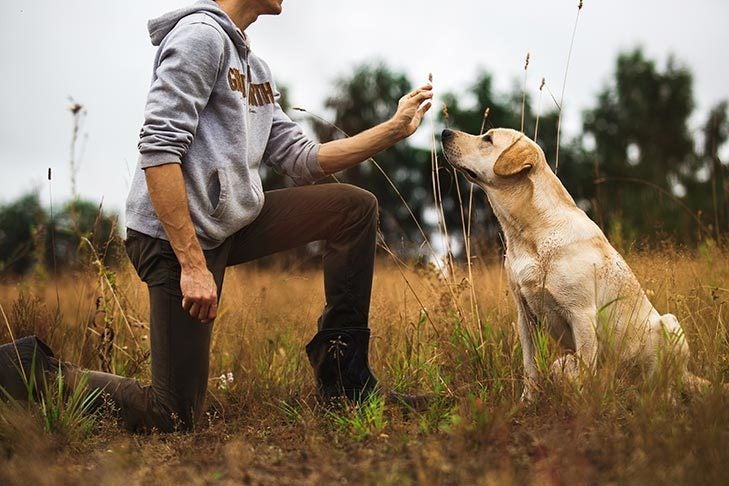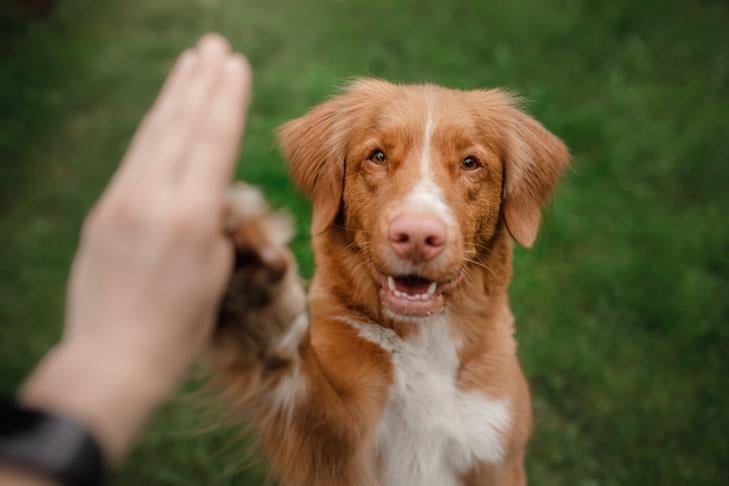What Is the Meaning of the Click?
The clicker is merely a way to mark a moment. There is nothing magical about that specific noise, except that you likely never make it around your dog outside of training. Therefore, you can substitute anything as a marker as long as it’s distinct from other ways you communicate with your dog. For example, you could snap your fingers, blow a whistle, or cluck your tongue. Many people use a marker word, like “Yes” or “Good.” For a hearing-impaired dog, you could use a light or a gentle tap on the shoulder.

Of course, the click or other marker itself is meaningless until it’s paired with a reward. The click simply indicates a reward is on the way. Although edible treats are the best incentive for most dogs, a reward is anything your dog values. So if your pup would rather work for a game of tug-of-war than a chunk of chicken, play that instead. The important part is timing and consistency. The click must mark the correct moment and every click must be followed by a reward.
In positive reinforcement training, a dog is rewarded after performing a desirable behavior. Without the use of a clicker or other marker, it might be obvious to the trainer what is being rewarded, but is it obvious to the dog? For example, when teaching a dog to lie down, how do you make it clear you are rewarding the belly on the ground? You have to make sure the reward is given while the dog is lying down rather than the dog getting up to get it. Otherwise, the dog might think the reward is for standing up or walking toward you. That’s easy with food treats, but impossible if the reward is a round of fetch or tug.
What about dogs who pop up from a down as soon they touch the floor? You can’t possibly get the reward to them fast enough. Or, what about more challenging behaviors like those performed at a distance? How do you get your dog a reward for jumping through a hoop at the exact moment they pass through the hoop? That’s where the power of the click or other marker comes in. The click marks the moment you are going to reward, then bridges the gap in time until the reward arrives. Your dog knows exactly what action was correct.
But couldn’t you just use praise in the same way? You could, but it’s not nearly as clear. You communicate with your dog using praise all the time. In fact, it’s a wonderful part of rewarding your dog. Plus, there is nothing about praise that is specific to the training situation, nor would you want that to be the case. Gushing over your dog is part of the joy of dog ownership. Using a clicker or other training-specific marker prevents confusion about the reward to come.
On top of the benefit of clarity, clicker-trained dogs tend to love learning. They want to train and work hard to earn a click. From your dog’s point of view, mark and reward training makes teaching new behaviors a game. It takes the pressure off the trainer too. Looking for clickable moments means you focus on your dog’s good choices, rather than dwelling on mistakes. Like any form of positive reinforcement training, clicker training boosts your communication, builds your bond with your dog, and makes training fun.

Clubs Offering:
Dogs repeat behaviors that get them what they want. That’s why positive reinforcement dog training focuses on rewarding your dog for the behaviors you want to see. If you give your dog a treat for giving you a paw, for example, your dog will be more likely to give you a paw in the future.
But where do clickers and markers fit in? You may have heard of clicker training, also known as mark and reward training. Is it an unnecessary gimmick? Quite the opposite. A clicker (or marker) is a tool that can make positive reinforcement training more efficient. After being repeatedly associated with a treat or reward, a clicker becomes a conditioned reinforcer. Learn how clicker training can help you better and more effectively communicate with your dog during training sessions.
Clicker training is the same as positive reinforcement training, with the added benefit of a clicker. A clicker is simply a small mechanical noisemaker. The techniques are based on the science of animal learning, which says that behaviors that are rewarded are more likely to be repeated in the future. So rather than focusing on what your dog is doing wrong, and taking good behavior for granted, clicker training flips the script and concentrates on what your dog is doing right. By telling your dog what to do, instead of what not to do, you can have an incredible effect on how your dog chooses to behave.
The value of the clicker is that it tells your dog exactly which behavior you’re rewarding. By clicking at the right time, you can “mark” the moment your dog did what you wanted. So rather than having to guess what you liked, the click tells your dog precisely what they did correctly. For example, if you’re training your dog to sit, you would click at the moment your dog’s butt hit the ground.
Is Clicker Training Right for your Dog?
If you have a dog, you probably have heard how clicker training is supposed to be more fun (and effective) for both you and your dog. It is also touted as enabling a faster learning turnaround than the more traditional voice command training. Hearing that clicker training is a better option, you may have tried it, or you may be tempted to try it. Before you do, here are some of the tips that we have discovered by researching what leading dog trainers have to say.
The Puppy Training Shortcut: Clicker Training Explained
MetLife Pet Insurance1 helps take the worry out of covering the cost of unexpected visits to the vet with your furry family members.
Pet health tips, fun DIY pet projects, frequently asked questions, and helpful information about pet insurance.
If you have questions about a claim or need help with your existing plan, our friendly pet advocates are here to help you get on the right track.